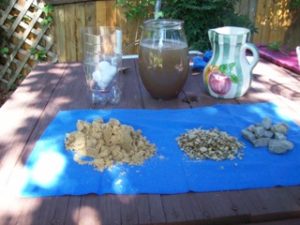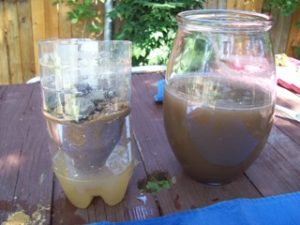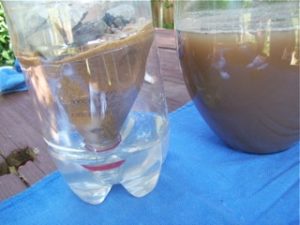
Pat Kellogg Roller, Children’s Science Specialist/Teacher/Retired
INTRODUCTION/OVERVIEW
CLEAN DRINKING WATER IS RARE AND PRECIOUS. Most of the water on our planet is salt water and it cannot be drunk. To save water and to help keep it clean, everyone needs to practice Water Conservation. Check our “Earth Care and Share” page on this website for how.
Turn on the tap. Fresh, clean, drinkable water pours out! That water may come from a nearby lake. The lake gets water from runoff water when it rains. The water runs over land that is dirty. The water in the lake is dirty. It has a medium brown color.
How is dirty water cleaned? Let’s have some science water fun! Water experiments are cool and wet! How about a great outdoor water Science Fair Project? Let’s use natural stuff as water filters to make dirty water clean water. Let’s make natural homemade ‘Water Filter Systems and experiment with them.
Violent weather events, earthquakes, and floods are becoming increasingly common. Often this means there is no drinkable water for days. Survival Training for Kids has become important. Knowing how to make dirty water clean and safe to drink anywhere you are is a valuable skill well worth developing.
WATER FILTER SYSTEMS: MATERIALS LIST:
1 . Each Cooperative Learning Group of kids needs three (2 liter) pop bottles cut in half horizontally. Collect them.
2 . Cotton pads
3 . Sand, pea gravel and larger gravel pieces of rocks
4 . Medium brown dirty water
5 . A measuring cup
6 . Notepad, pencil and a camera (if one is available). If not, drawings will be fine.
PROBLEM: Which natural filter system changes dirty water to clear water best? (Best means: how many times did you have to run the water back through the filter before it was clear?) The fewer repeats, the better the filter.
HYPOTHESIS: The filter system containing _________________________________________, cleared up the water best. (Take a guess, then test.)



PROCEDURE:
Hint: Cut each two liter pop bottle around about 1/2 from the top of the bottle. When turned over, the top half of the pop bottle looks and acts like a funnel. The natural stuff goes in this part in this order:
1 . Put 4 cotton balls in the spout so the filter stuff cannot fall through to the other half of the bottle which catches the filtered water.
2 . Add the natural stuff on top of the cotton balls. Set up 3 pop bottle systems as follows:
a. cotton balls + sand b. cotton balls + pea gravel c. cotton balls + larger gravel
3 . Pour 2 cups (500) ml. of dirty water on top of the filter stuff for each filter system. OBSERVE AND RECORD WITH WORDS AND DRAWINGS.
4 . Keep pouring the filtered water back through each system until it is clear. (RECORD HOW MANY TIMES IT TOOK, for the water to become clear, if it did.) Keep a record of how many times it took.
5 . Which of these systems worked best? Draw pictures, or take photos.
GOING FARTHER IN BUILDING CREATIVE PROBLEM-SOLVING SKILLS.
Clean up these systems, Then make up your own filter mix and see how it works.CLEAN UP Clean up again and continue until you have created the fastest, best water filter mix. If you improved on the first experiment we tried, then you are eligible for the Super Scientist – SUPER FILTER’AWARD!
RESULTS: My hypothesis was (true) – (false). (Write down the one that fits your first experiment.) Then tell what you learned from all your experimenting.
SHARING IS CARING Use your drawings, photos and words to prepare a great report to share with others. Ask your parents or teacher to take you to visit a water filtering plant. Or GOOGLE Water Treatment Plant. Find out everything they do to water to make it safe to drink.Include this as research if you do this as a SCIENCE FAIR PROJECT. Be sure to repeat the experiments 3 times for a science project.
Google how to make water safe to drink for clues about treating it at home – boiling for 20 minutes, adding chemicals such as a tiny bit of bleach etc. YOU NEED TO KNOW HOW TO DEAL WITH A DISASTER WHICH HAPPENS,AFFECTING YOUR WATER SUPPLY. It’s also great to know if you are camping and need to drink water from a creek or stream.